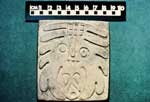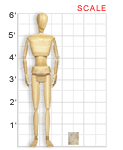From the collection of:
William S. Webb Museum of Anthropology || VAM Home
Adena Culture
GAITSKILL STONE TABLET, Middle Woodland Period, c. 500 BCE-300 CE
Gaitskill Mound, Montgomery County, Kentucky
Bas-relief, fine-grained sandstone; 9.25 cm. X 8.0 cm. X 1.6 cm.
Catalog Number 15MM5-14
William S. Webb Museum of Anthropology, University of Kentucky
Over the years, 13 Adena tablets have been discovered in Ohio, West Virginia, and Kentucky, but the figure engraved on the Gaitskill tablet is unique. Unlike most of the other Adena tablets, which depict multiple figures or designs, only the Gaitskill tablet depicts a single figure carved in relief. Several suggestions have been offered as to what the figure represents. The most common interpretation is that it is a human face, possibly representing a ceremonial mask, in which circular eyes, a nose, and a row of triangular teeth can be distinguished. If the tablet is inverted from the orientation shown here, the face is still apparent, with the same eyes and nose, but now with a toothy mouth at the bottom. The upper portion suggests the antlers of a deer, perhaps representing an antlered headdress. However, other interpretations include a human hand, the head of a winged or feathered serpent, and even an insect.
The possible function of the tablet is not quite as speculative as the representation. Most scholars believe that it was used as a block-printing or stamping device, possibly to decorate animal skins or even human bodies. The low areas of the tablet appear to have a red staining, and the raised design is very smoothly polished.
While its design and use are still debated, the fact that the artifact was found in a ceremonial mound suggests that the item and its image were of considerable importance to people of the Adena culture.
Classroom Ideas
Discussion: What kinds of tools do you think the Adena people would have used to carve this tablet? What do you see when you look at it? What reasons might the Adena people have had to decorate their bodies or animal skins? Can you think of any other ways they might have used this tablet?
Activity: The Adena people are believed to have used these carved stones as a sort of stamp. Instead of stone, use a large eraser to create your own unique stamp. With a marker, draw the pattern you would like to carve on a new eraser. Remembering that only the raised areas, not the areas you carve away, will print onto the paper, cut away the excess material around your design. Once you have finished carving, press your stamp in an inkpad or water-thinned paint, then press it onto a piece of paper. You might repeat the stamping process to create an interesting pattern on your paper.
Links
Learn more about Kentucky archaeological sites and discoveries at the Kentucky Archaeological Survey web site.
[www.kyheritage.org/kas.htm]
Read the article Essential Features of Adena Ritual by R. Berle Clay at the Glen A. Black Laboratory of Archaeology.
[www.gbl.indiana.edu/abstracts/adena/contents.html]
The Adena People: Moundbuilders of Kentucky, a six-minute video, can be viewed online at the Archaeology Channel.
[www.archaeologychannel.org]
See the William S. Webb Museum of Anthropology site for lots of teaching resources, including information about time periods, online activities, and lesson plans.
[www.uky.edu/AS/Anthropology/Museum/museum.htm]

